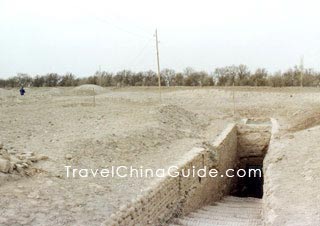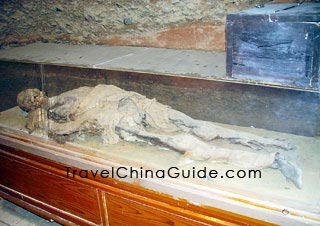Astana-Karakhoja Ancient Tombs
 |
| Astana-Karakhoja Ancient Tombs, part of the Underground Museum of Turpan |
The tombs are located 42 km (26miles) southeast of Turpan city and 6 km (3.7miles) from the Ancient City of Gaochang. The tombs were the public cemetery of the ancient Gaochang residents, both aristocrats and commoners. Among the excavated 456 tombs, the Gaochang king's has not been found.
The tomb complex is 5 km (3.1miles) from east to west, and 2 km (1.2miles) from north to south. Gravel boundaries separate the tombs by family. The paternal family burial order was strictly followed, similar to the system in the Hexi Corridor (today's Gansu Province), and even in central China. Generally, husband and wife were buried together. In some cases, one man was accompanied by two or three women.
A slope of over 10 meters (32.8 feet) long leads down to the chamber. The chamber is 2 meters (6.6 feet) high with a flat ceiling or a dome. The dead are placed on an earthen or wooden bed in the back of the chamber. They had wood in both hands and wore cotton, linen or silk clothes. Around them are miniature pavilions, carts and horses, parades, musical instruments, chess sets, pens and ink, grapes, melons, dumplings and pancakes -- to be used by the dead in another world. Owing to the arid climate, the relics are very well preserved; dumplings are the same as today's, and the stuffing is as intact as it was when fresh. Murals with vivid pictures of humans, animals, flowers, mountains, and rivers decorate some chambers. A painting of ladies playing chess illustrates the happy life of aristocrats in the early Tang Dynasty (618-907).
 |
| Dried Corpse in the ancient tombs |
It is noteworthy that mummies here compare favorably with Egyptian mummies in both quantity and the quality, providing precious specimens for anthropology, history, medicine, and ethnology. The mummy of the well-known Gaochang General is 1.90 meters (6.2 feet) tall with well-preserved beard hair and clothes.
Tips:
1.Currently three chambers are open to the public. For your own safety do not enter the unopened areas.
2. Do not touch the mural inside the chambers.
| Admission Fee: | CNY 20 |
| Recommended Time for a Visit: | Half an hour |
- Last updated on Aug. 15, 2025 by Demi Li -